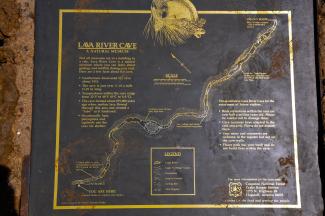Lava River Cave
Calling all spelunkers!
The Flagstaff-area Lava River Cave is a natural museum of sorts open to the public for underground hiking adventures. Bring a flashlight or a lantern... and watch your head!
Site History
Discovery
Lumbermen working for the Saginaw and Manistee Lumber Company discovered Lava River Cave in about 1915. Homesteaders are said to have visited Lava River Cave throughout the seasons, using it to harvest, store and collect large quantities of ice.
Formation

The cave likely formed within a few hours of a brief volcanic eruption. The cave as it appears today appears close to the same as it did right after its formation.
Lava River Cave is a unique kind of cave known as a "lava tube." It's the longest lava tub in Arizona at about 1 mile long.
Geologists believe Lava River Cave was formed between 650,000 and 700,000 years ago when molten lava erupted from a volcano near the present-day site of Hart Prairie. The top, sides and bottom of the flow cooled and solidified first, after which the insides of the lava river continued to flow emptying out the present cave.
Ample evidence of how the tube was born is written in the rocks of which it is formed. Small wave-like undulations in the floor are the remains of ripples frozen in the last trickle of molten rock that flowed from the cave. Stone icicles hanging from the ceiling show where a final blast of volcanic heat caused the rock to partially re-liquefy and drip. Shortly after the ceiling hardened, rocks fell into the still-flowing floor and floated downstream before the floor also hardened. Cracks in the floor, ceiling and walls formed as the lava shrank when it cooled and hardened.
The lava flow features within Lava River Cave may not seem particularly fragile, but they are more than half a million years old and cannot be repaired or replaced.
A variety of lava flow features also used to exist outside the cave but have long-since been washed away by wind and rain, and overgrown by plants.
Visit
Visit the Lava River Cave

Interested in spelunking? Visit our Lava River Cave recreation site for information about cave rules, amenities, safety and more.
Lava River Cave Features
Cave Creatures
Lava River Cave is home to a variety of animals and insects, including crickets, beetles, porcupines, squirrels and bats. While it's rare to observe one of these creatures insde the save, their droppings have been found beneath rocks and alongside the walls.
Bats, notably, have a prominent presence inside Lava River Cave!
Bats and other creatures are vulnerable to human disturbance. Please remember to treat any creatures you encounter in the cave with respect. You are a visitor in their home.
Nature's Refrigerator
As an underground geologic feature, Lava River Cave remains much cooler than it's above-ground environment year-round. Even on 90-degree summer days, temperatures inside the cave can still measure as low as 35 degrees, and ice is fairly common.
The lava rock that formed the cave is an excellent insulator. It's dense and dark enough to prevent the sun's heat from traveling through the earth and into the cave. The cave's shape also helps it to retain its cold temperatures. Since hot air rises and cool air sinks, cold air falls into the cave through the winter and remains trapped throughout summer.
Recent Restoration Work
Litter and graffiti have been problematic inside Lava River Cave since the late 1960s.
A major restoration effort of Lava River Cave was organized in May 1991, when most litter was hiked and packed out and extensive graffiti removal was conducted.
The Coconino National Forest asks that visitors help maintain Lava River Cave for the enjoyment of future visitors by refraining from littering and vandalism.



